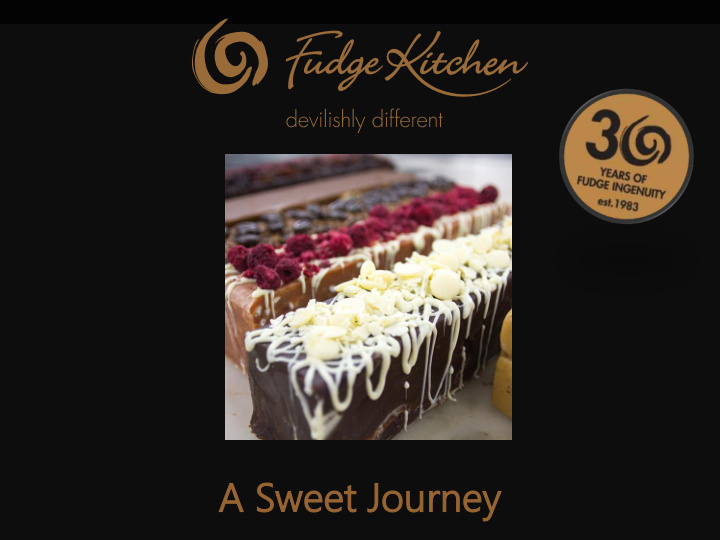



A S Swee eet Jo Journ urney ey
Our Heritage – Who We Were Born 30+ years ago Retail theatre concept Hand producing in front of customers at each shop USPs of product quality, freshness & amazing staff Began to develop new ranges for wholesale market 6 years ago Even 3 years ago had not considered that exporting could form a key part of our growth strategy
A Strategic Decision to Grow Demand from other Retailers Trends in the speciality food market Gap in the UK market for a gourmet fudge We decided to create a new arm to the business with a clear objective: Aim: to establish Fudge Kitchen as the primary gourmet fudge brand within the Speciality Food and Gift Food Markets
First Step : Conquering the UK • Although established on the High Street it took time to convince UK buyers that fudge could sit alongside premium chocolate • 6 years later, we have carved a unique niche in the UK premium confectionery market; known for our innovative approach and high product quality (11 GTA Awards) • Have listings with over 250 UK stockists across many markets – from independent retailers, food service (e.g. Claridges, Radisson, Hilton & Wembley stadium), garden centres and foodhalls, dept stores (Fenwicks, Adnams), Selfridges, Harrods, corporate events & gifts & more • In the last five years, our year on year growth has increased by an average of 40% & capacity 10 fold
Who Are We Now? In the last 6 years we have created over 70 new lines split across 6 Complimentary Groups: Whipping Gourmet Liquid Drinking Home Caramels Cream Fudge Butter Fudge Fudge Sauces Fudge Kits & Brittles
Pressing the HELP Buttons We sought help wherever we could: Knowledge Transfer Partnership: product shelf-life extension MAS: grants, mentoring, courses Design Leadership Programme: branding Local IoD/Food Groups: market & business info Growth Accelerator: mentoring and training finance UKTI: export advice & training 2Seas: introductions to export through visits Enterprise Europe Network: export advice & assistance
First Steps into the Wider World • Considered the possibility of export early on • Had assistance through the EEN to a market visit to SIAL Paris and then the 2 Seas program to Tavola some 4 years ago • From these early visits we began to understand: – The growth in speciality food and desire for hand made, premium products extends outside of the UK – British confectionery is well thought of in some regions – Not all nations mirror the UK’s love for sugar – some have sugar taxes – Outside of the other English- speaking countries ‘fudge’ essentially doesn’t exist – Flavour preferences vary enormously
Accessing New Markets • There are many routes to potential new markets – where to start? • Membership of Trade Associations, Organisations & Agencies – A great place to start gathering info – EG: 2 Seas (or the new equivalent!)/ EEN/ FDEA/DIT (UKTI) with Passport to Export – Published Data and Advice • Organised Trade visits to trade shows or Meet the Buyer Events – The next step – Enables direct and relevant market info gathering – First hand experience with overseas buyers – Product sampling for direct feedback – networking with other exporters is invaluable
Our Routes to New Markets • After initial researches we decided that exhibiting at specialised Trade Shows would be our principle route to market • We have generally secured some grant support through UKTI (DIT) • We now undertake 2 principle overseas shows each year in addition to supporting distributors at 2 other events • It takes time to be accepted by foreign buyers – this is not a quick fix, but with tenacious follow up it is now proving to be fruitful in our 3 rd year
What Have We Learned? • You have to be prepared to adapt your offering - be Flexible. 1 size does not fit all • For us this has meant learning that: – Portion sizes – the Dutch & Germans prefer 100g pieces, the French & Belgians much smaller – The Spanish & Italians don’t like fudge but love brittles and caramels and things covered in chocolate – The Far East love our packaging, but our products are too sweet for them! – Flavours – Scandinavia loves liquorice, the Middle East prefer cardamom, rose & cumin
Doing the Deal – Our Experience • Export is no different to any other business – if it doesn’t feel right, don’t do it. Build relationships. • Start easy – direct supply to customer - in sterling – you can play with currency when you have confidence • Learn the acronyms but in truth understand what each deal involves, mostly when title transfers from you to the customer • Get appropriate insurance • If in doubt operate Proforma. • Use distributors rather than agents and don’t offer exclusive without time frames and targets • In pricing, understand that export will require tight margins to allow for all potential over - labelling, transport and middlemen costs • Do not under price
In Summary • Exporting can be a great way to grow • It now represents 10%+ of our growing business and is set to double in the coming year • It takes time, tenacity & a flexible approach • There is lots of help – connect and use it & • Do some homework & create a simple strategy
Recommend
More recommend